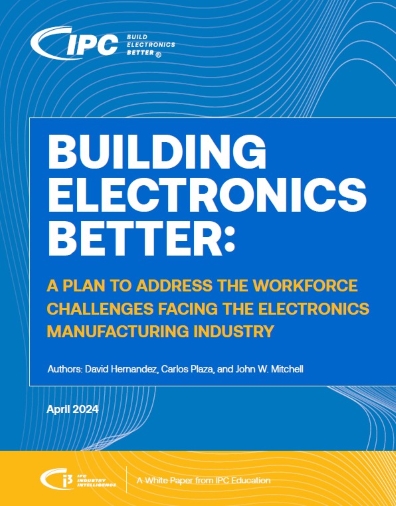Recruiting the Next Generation
By Kate Koger, IPC public affairs coordinator
Many companies across the electronics manufacturing industry are struggling to recruit qualified candidates for technical positions. At the same time, younger generations are struggling to find profitable, skill-building work in a competitive job market that does not prioritize career development. This disconnect perpetuates substantial workforce gaps that the growing U.S. electronics manufacturing industry is ill-prepared to address.

In response, IPC recently released a new white paper, "Building Electronics Better: A Plan to Address the Workforce Challenges Facing the Electronics Manufacturing Industry." The white paper provides a framework for establishing an industry-wide talent pipeline and career pathways aligned to the needs of both workers and business. Talent pipelines and career pathways work together to bridge the gap between available skills and job opportunities. Talent pipelines focus on recruiting and nurturing potential candidates, while career pathways provide clear progression routes within the industry, ensuring that employees can continuously develop their skills and move into higher-level positions.
I recently had a conversation with an industry executive about the challenges they are facing with their workforce. The executive said that they were struggling with recruiting because it’s hard to find candidates with the right skills and qualifications to work on the highly technical and expensive electronic components their company produces. This is a common issue in the electronics manufacturing industry today.
One potential solution is to recruit young talent at the operator level and provide them with well-defined career pathways that facilitate their progression to the role of technician or engineer. The "Building Electronics Better" white paper explains that career pathways outline the progression from entry-level to advanced roles, including the necessary education, training, and experience for each step within an industry. The paper also describes IPC’s comprehensive suite of industry-defined workforce training programs that companies can use to train workers for each role in a pathway. Developed in collaboration with industry experts, these courses cover all the essentials, allowing companies to reserve their training dollars only for company-specific protocols and processes.
An effective talent pipeline aims to raise awareness among a wide range of potential workforce candidates. However, focusing on the school-to-industry segment of the pipeline has the added benefit of accessing a pool of technologically savvy candidates with fresh perspectives, which is essential for an industry driven by rapid innovation. Younger generations are well-equipped to assist companies in evolving with the world’s rapidly increasing focus on social issues like sustainability and diversity. Moreover, companies that capitalize on their commitment to continuous learning and career development will greatly benefit from a dynamic and skilled workforce, crucial for maintaining a competitive advantage in the global market. It’s important to note that the clock is ticking. With many current employees nearing retirement, it is imperative to get the talent pipeline flowing to ensure the transfer and retention of an organization’s institutional knowledge.
So, how do we attract younger talent? The current culture in the United States has put such heavy pressure on four-year degrees that lower-level positions are harder to fill. Gen Z students are getting degrees and aiming for higher-level positions, skipping entry-level roles like operator positions. We need to remind students, while they are still in high school, that options like apprenticeships and trade schools are not only valuable but also smart and often less expensive. There are multiple strategies that companies can implement to change the culture and show younger generations that working in the electronics manufacturing industry is a great option.
One of the most effective ways to attract younger talent to the workforce is by offering hands-on learning opportunities through internships and apprenticeships. These programs allow young workers to gain practical experience, helping them build the skills and industry knowledge necessary for a successful career. While apprenticeships have become less common in recent years, they remain a valuable entry point into technical industries like electronics manufacturing. Revitalizing these opportunities will help cultivate a skilled workforce and provide alternative career paths to the traditional college route, making the industry more accessible to a broader range of young professionals. In addition to hands-on training, companies should embrace digital platforms to raise awareness about career opportunities in electronics manufacturing. Leveraging LinkedIn, Instagram, and TikTok can help companies showcase their culture, highlight innovative projects, and share employee experiences in a way that resonates with Gen Z. Creating engaging content tailored to younger audiences can shift perceptions of entry-level roles and apprenticeships, sparking excitement for careers in the industry. By partnering with educational institutions for workshops, career fairs, and co-op programs, manufacturers can build a pipeline of fresh talent. Investing in Gen Z through these strategies will help close the skills gap and secure the future of electronics manufacturing.
Read more about addressing workforce challenges in IPC’s recent white paper: https://edu.ipc.org/ipc-workforce-whitepaper
